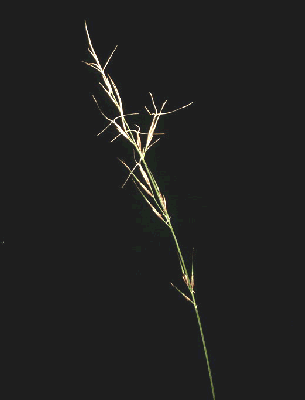 |
 |
|
 |
 |
|

Aristida ramosa R.Br. |
Common name
Purple Wiregrass
Prickly Threeawn
Derivation
Aristida L., Sp. Pl. 1: 82 (1753); from the Latin arista
(an awn).
ramosa- from the Latin ramus (branch) and -osa (abundance), alluding the branched culms.
Published in
Prodr. 173 (1810).
Habit
Perennial, tufted. Culms erect, 37–103 cm tall, 2-noded. Mid-culm internodes
smooth, glabrous. Lateral branches sparsely branched or branched. Ligule a fringe
of hairs, 0.5–1 mm long. Collar glabrous or pubescent. Leaf-blades straight,
flat or conduplicate or involute or convolute, 6–12 cm long, 0.6–2
mm wide. Leaf-blade surface scabrous, glabrous or pubescent.
Inflorescence
Inflorescence compound, a panicle. Panicle contracted, lanceolate, 8–27
cm long, 1.5–6 cm wide. Primary panicle branches appressed, moderately
spaced, 2–5 cm long, bearing spikelets almost to the base. Panicle branches
with insignificant pulvini.
Spikelets
Spikelets solitary. Fertile spikelets 1-flowered, comprising 1 fertile floret,
without rhachilla extension, lanceolate, terete, 6–14 mm long, breaking
up at maturity. Spikelets disarticulating below each fertile floret. Floret
callus elongated, 0.5–1.2 mm long, pubescent, acute.
Glumes
Glumes persistent, similar, thinner than fertile lemma. Lower glume lanceolate,
3.7–9 mm long, 75% length of upper glume, membranous, 1-keeled, 1(–3)-nerved,
midnerve smooth to scabrous. Lower glume lateral nerves absent or obscure. Lower
glume surface smooth to scabrous, glabrous. Lower glume apex acute or acuminate.
Upper glume lanceolate, 5.2–10.7 mm long, 70–80% of length of
adjacent fertile lemma, membranous, 1-keeled, 1-nerved. Upper glume lateral
nerves absent. Upper glume surface smooth to scabrous, glabrous. Upper glume
apex entire or erose, emarginate or obtuse or acute or acuminate or cuspidate,
mucronate.
Florets
Fertile lemma lanceolate, subterete, 6–14.1 mm long, coriaceous, pallid
or light brown, concolorous or mottled with last colour, 3-nerved. Lemma surface
smooth or scaberulous or papillose or punctate. Lemma margins involute or convolute,
covering most of palea. Lemma apex acute, 3-awned. Median (principal) awn straight
or curved, spreading, flat below, 8–20 mm long, without a column, persistent.
Lateral lemma awns present, spreading as much as principal, 7–17 mm long,
subequal to principal or shorter than principal, 85–87% of length of
principal. Palea 20% of length of lemma, without keels. Anthers 3, 1.3–1.9
mm long. Grain with adherent pericarp, not grooved or grooved, 5–8.7 mm
long. Embryo 25–50% of length of grain. Hilum linear, 50% of length
of caryopsis.
Continental Distribution:
Australasia, Pacific.
Australian Distribution:
Western Australia, Queensland, New South Wales, Victoria.
Western Australia: Drummond, Dale. Queensland: North Kennedy, Leichhardt, Burnett, Wide Bay, Darling Downs, Moreton, Gregory North, Warrego, Maranoa. New South Wales: North Coast, Central Coast, South Coast, Northern Tablelands, Central Tablelands, Southern Tablelands, North-Western Slopes, Central-Western Slopes, South-Western Slopes, North-Western Plains, South-Western Plains. Victoria: Riverina, Midlands, Victorian Volcanic Plain, Gippsland Plains, East Gippsland.
Classification. (GPWG
2001):
Aristidoideae
Notes
Native. A few other records from New South Wales and Queensland, and one anomalous
collection from the Darling Range in south-west Western Australia. Acacia,
brigalow (Acacia harpophylla), blue-grass downs (Dichanthium
spp), Eucalyptus, Eremophila and Triodia communities, rainforest
fringes on clays, red earths, sandy and alluvial soils. Flowering and fruiting
all year.

Inflorescence (photo)
© Watson and Dallwitz 1992